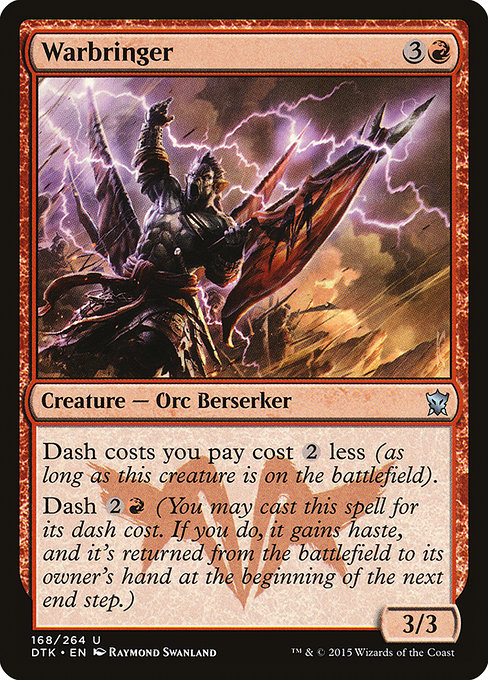
Image courtesy of Scryfall.com
From Unglued to Urgency: Why Un-cards Matter in MTG Design Theory for Warbringer
Design theory in Magic: The Gathering isn’t a dry classroom exercise; it’s a living conversation between rules, timing, and player imagination. The world of un-sets, joke cards, and experimental formats (the so-called Un-cards) has always functioned as a sandbox where designers test boundaries without endangering the core game’s balance. When you bring that mindset into a card like Warbringer—an uncommon red creature from Dragons of Tarkir—the theory becomes tangible. Warbringer embodies tempo, risk, and a dash of chaos that designers chase, inspired by the playful spirit of un-sets and the serious craft of competitive play alike. 🧙♂️🔥
Warbringer is a four-mana commitment: {3}{R} for a 3/3 Creature — Orc Berserker. That statline sits in a familiar red sweet spot: enough aggression to threaten, but just vulnerable enough to invite trade or risky plays. Its real flavor, however, sits in its Dash mechanic. Dash costs you pay cost {2} less (as long as this creature is on the battlefield). Dash {2}{R} (You may cast this spell for its dash cost. If you do, it gains haste, and it's returned from the battlefield to its owner's hand at the beginning of the next end step.)
In practical terms, Warbringer rewards tempo without becoming a one-note armory. Played traditionally, it’s a sturdy 3/3 for four with a snap-punishing drawback if you overextend. Played as a dash creature, it ambushes the opponent with haste and returns home, potentially re-arming you for another swing. That tension—invest now for pressure now, or invest later for longer-term threats—illustrates a core design principle that un-sets probe: how far can you push a rule before players feel tricked rather than delighted? The answer, often, lies in a playful balance between clarity and surprise. ⚔️
Design Theory in Practice: Dash as a Case Study
- Tempo over raw power: Warbringer’s dash option turns a reliable body into a tempo engine. The ability to cast for {2}{R} plus the potential discount when the creature remains on the battlefield emphasizes decision-making: do you squeeze a fast early impact at the risk of leaving your board vulnerable next turn?
- Rule interaction as storytelling: The dash-return-to-hand clause tells a story of a short, aggressive blitz—your berserker launches a furious attack, then vanishes briefly, re-emerging when the coast is clear. That kind of narrative clarity is precisely what un-sets crave: rules should feel intuitive, but with room for clever play.
- Costs and risk: The cost-reduction twist—“cost {2} less as long as this creature is on the battlefield”—nudges players to value battlefield presence. It’s a micro-lesson in how state-based effects and static abilities can reshape decisions, a cornerstone of design theory that un-sets love to play with in the margins. 🧠🎲
- Color identity and archetype texture: In red, speed and risk go hand in hand. Warbringer reinforces red’s identity not just through flavor, but through the calculus of whether to deploy a dash drop now or hold for bigger, flashier threats later. The card’s rarity (uncommon) and its multi-format legality (modern, legacy, etc., in constraints) further illustrate how a single mechanic can ripple across formats and deckbuilding styles. 💎
Un-cards remind designers that the fun in MTG often comes from pushing expectations without breaking coherence. Warbringer stands as a case where a single mechanic—Dash—opens a design dialogue about timing, value, and the joy of surprise. When you watch players pilot a Warbringer, you can hear the design theory in action: the tempo play, the edge of volatility, the moment where haste makes all the difference. 🧙♂️
Beyond the tabletop, the Warbringer aesthetic—orange-crimson hues, jagged edges of the Orc Berserker figure, a sense of kinetic momentum—echoes why the story of MTG design is as much about art and mood as it is about statistics. The Dragon of Tarkir era emphasized clan identity and dtk’s vibrant color synergy, turning red’s brutality into a tactical puzzle. Warbringer’s dash synergy is a small mirror to the larger truth: design thrives when mechanics, flavor, and player psychology dance together in rhythm. ⚔️🎨
Connecting with the Community and Collectors
Warbringer’s journey from a mechanical idea to a collectible item mirrors the collector’s mindset that fuels much of MTG’s culture. The card’s foil and non-foil finishes, its set symbolism, and its charm as part of the Dragons of Tarkir lineup give players reasons to trade, rate, and season their decks with care. The Un-cards influence here isn’t about literal silver-bordered chaos; it’s about inviting players to explore the edges—what if a card could feel like a tempo trick, a bluff, or a rush of adrenaline all at once? That curiosity is the lifeblood of meta-shifts and new archetypes. 🔥
As we think about cross-promotions and fan-friendly content, consider how everyday gear can echo that same spirit of exploration. For instance, a sleek, ultra-slim phone case—like a Slim Lexan Phone Case for iPhone 16—becomes part of the fan’s ritual: a pocket-sized companion for tournament nerves, notation, and card-sleeved strategy sessions. It’s a small reminder that MTG culture blends collector’s drive, design curiosity, and everyday practicality into one vibrant hobby. Check out the product linked below to see how merchandising can echo the same design ethos we celebrate in the game. 🧳📱
Slim Lexan Phone Case for iPhone 16 — Glossy Ultra-SlimMore from our network
- https://blog.digital-vault.xyz/blog/post/falkenrath-aristocrat-graveyard-recursion-strategic-reanimation/
- https://crypto-acolytes.xyz/blog/post/bitcoin-halving-how-miners-adapt-to-lower-block-rewards/
- https://crypto-acolytes.xyz/blog/post/crypto-taxes-on-gaming-earnings-what-gamers-should-know/
- https://crypto-acolytes.xyz/blog/post/dota-2-vs-heroes-of-the-storm-which-moba-reigns/
- https://crypto-acolytes.xyz/blog/post/what-is-cloud-mining-a-clear-guide-to-remote-crypto-mining/